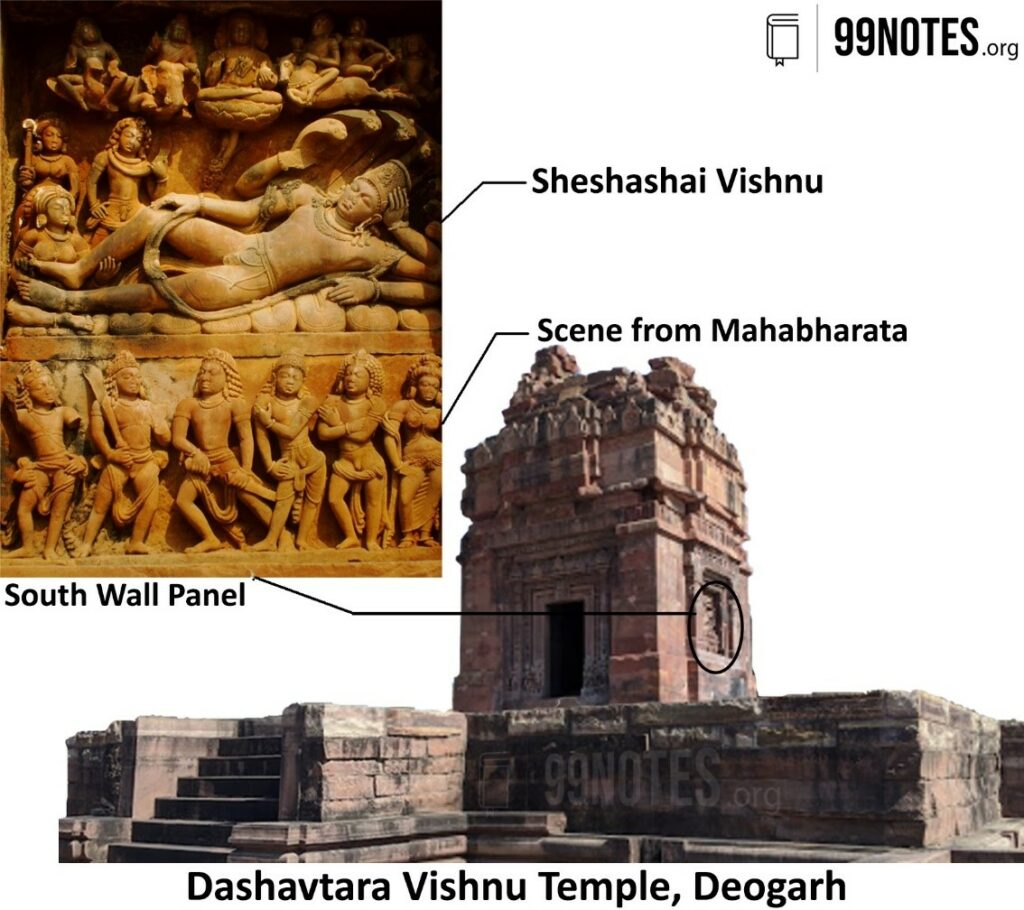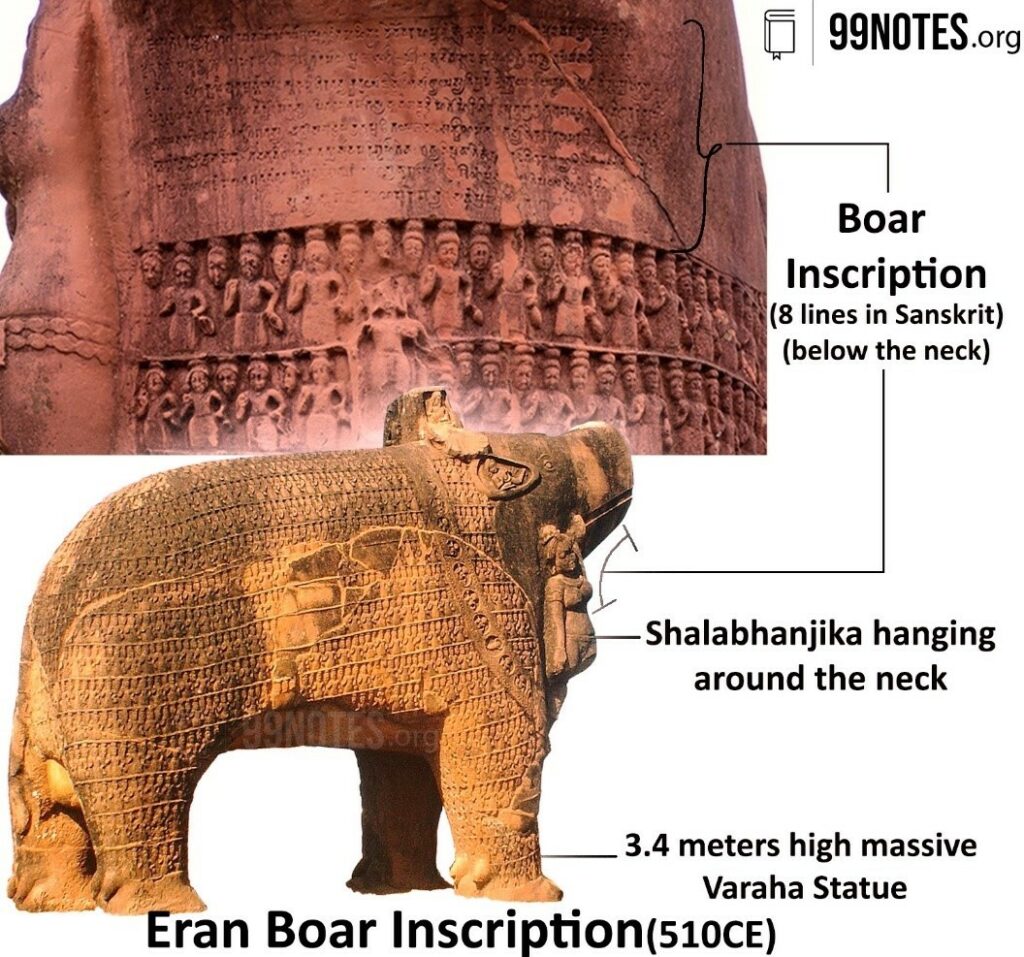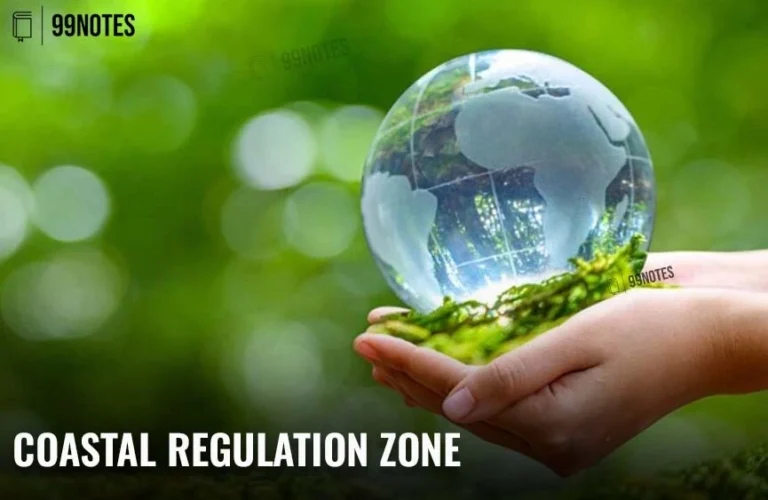Golden Age of India: Gupta Period Notes for UPSC
The Gupta Age was a Golden age of Economy, Literature, Science, Mathematics, Astronomy and Art, even though it was in no sense a Golden age for the untouchables, slaves and women. We have already discussed the Gupta Economy in the [Previous Page], and now we shall discuss the other aspects of the Gupta society.
Art and Architecture
The Gupta reign can be considered a starting point of the Golden period in Indian Temple Architecture. Other forms of art such as painting, sculptures etc. flourished too.
Temples
- The Nagara Style of temple building started in the Gupta period. Dashavatara Vishnu temple is the earliest example of a Panchayatana-style temple, with the main shrine and four subsidiary shrines.
- The Temples had a square sanctum and a pillared entrance during this period.
- The walls are heavily decorated with sculptures.

- Some major temples constructed by them are –
| Temple | Location |
| Shiva temple | Bhumara (Nagoda, M.P) |
| Parvati temple | Nachna Kuthara (M.P.) |
| Dasavatara temple | Deogarh (Jhansi, U.P) |
| A brick temple | Bhitargaon (Kanpur, UP) |
| Kankali Devi temple | Tigawa (Jabalpur, MP) |
Paintings
- Bagh cave paintings
- The Bagh caves are in the Dhar district of MP.
- The subject matter of paintings is portraits of Buddha and Jataka stories.
- Ajanta cave paintings
- The Ajanta caves of the Aurangabad district of Maharastra have 29 caves. The caves numbered 16, 17 and 19 are associated with the Guptas.
- The subject matter of paintings is portraits of Buddha and Bodhisattvas. For example, cave number 16 painting depicts various scenes of Buddha’s renunciation, and Cave number 17 shows Jataka stories, i.e. events from the life of Buddha and his multiple births.

Sculptures
- A Sarnath school of sculpture developed during the Gupta period. It used cream-coloured sandstone and metals.
- The sculptures were dressed and lacked any form of nakedness.
- The halo around Buddha’s head was decorated.
- The metal sculpting style continued too. Example: Sultanganj Buddha cast in copper.

Inscriptions
- Inscriptions of the Gupta empire are found on stone pillars, iron pillars and other objects made of rocks. These use a Gupta Brahmi script or the Late Brahmi script. It is also used by Hunas, Pushyabhutis and other feudatories of the time.
- All their inscriptions were written in Sanskrit, which was ignored earlier under the influence of Buddhist and Jain traditions that encouraged vernacular dialects like Pali, Prakrit and Ardhamagadhi. These inscriptions tell us about the Gupta empire. For example – The Prayag-Prashasti inscriptions contain details on the kingdom of Samudragupta I (335AD to 380AD).
- Prayag-Prashasti inscription (Prahasti means “in praise of “): is engraved on the Ashoka’s Allahabad Pillar by Harisena, the court poet of Samudragupta I (335AD to 380AD). It mentions the wars and extent of the empire:
- According to Prayag Prashasti, Samudragupta defeated nine rulers from Aryavrat (the plains of Ganga).
- Twelve rulers of the Dakshinapatha (South India) were defeated and allowed to rule again.
- It mentions the neighbouring areas of Assam, coastal Bengal, Nepal and several Gana Sangha who brought tribute, followed orders, and attended his court.
- The descendants of Kushanas and Shakas ruled border areas. The ruler of Sri Lanka submitted to him. They offered their daughters for marriage.
- Iron Pillar (Mehrauli) was constructed by Chandragupta II (380–412 AD) and contains his inscription (discussed later). It now stands in the Qutub complex at Mehrauli in Delhi.
- Eran stone pillar inscriptions – It is situated in Madhya Pradesh. Eran Inscriptions are:
- Inscription 1: It is a small pillar inscription at Eran inscribed by Saka king Sridharavarman, who ruled in Central India during 339-368 AD, together with his Naga military commander. Bhanugupta later wrote on this same Pillar on the reverse side. Bhanugupta’s inscription also mentions an instance of Sati.
- Inscription 2: The Eran Inscription of Samudragupta (336-380 AD) is presently stored in Kolkata Museum. It is a red sandstone inscription on the west of the ruined Varaha temple (discussed in Inscription 4). It is famous for its decimal Numeral scripts with at least “2, 3, 4, 5, 6 and 7” being preserved.
- Inscription 3: The Budhagupta inscription is dated 484–485 CE. It is a Vaishnava inscription. It describes that the Gupta kingdom stretched from the Kalindi River to the Narmada River. It marks the raising of a column in honour of Janardana, another name of Vishnu.
- Inscription 4: The Eran boar inscription of Toramana is the eight lines of Sanskrit inscribed on a Red Sandstone Boar Sculpture, representing the Varaha Avatar of Lord Vishnu adjacent a ruined temple. The inscription names king Toramana, a King of the Alchon Huns, as ruling over Malwa (“governing the earth”) and records that a Dhanyavishnu is dedicating a stone temple to Narayana (Vishnu).

Science and Technology during the Gupta empire
There was tremendous development of science during the Gupta empire. Many important discoveries were made and passed on to Europe by the Greeks and the Arabs.
Mathematics
| Author and their work | Features |
| Aryabhattiyam (499AD) by Aryabhatta | Awareness of both the decimal system and zero.Arithmetic, geometry, trigonometry and algebra.Computation of πSolid geometry. |
| Brahmagupta’s (7th century CE) Brahmasphuta Siddhanta and Khanda Khadyaka | Cyclic QuadrilateralSquare roots |
| Suryasiddhanta (late 4th century) | origin of Trigonometryearliest uses of Tangent, Inverse sine. |
Astronomy and Astrology
-
- Varahmihira wrote four books, Pancha Siddhantika and Brihata Samhita on Astronomy and Laghu Jataka and Brihaja Jataka on Astrology.
- For this contribution, Varahmihira is called the Father of Indian Astronomy.
Medicine
-
-
- Navanitakarn worked on Ayurveda during this era.
- Charak and Sushruta’s works Charaka Samhita and the Sushruta Samhita, respectively, were summarised in Ashtanga Sangraha by Vagbhatta I.
- Dhanvantari was a prominent doctor during this era. He wrote Dhanvantarisamhita, abook of medicines.
-
Chemistry and Metallurgy
-
-
- Nagarjuna is mentioned as a great chemist. [Not to be confused with the 2nd-century founder of Shunyavada]
- The use of mercury and iron in medicine shows that chemistry must have been practised.
- The famous Iron Pillar in the Qutub-Minar complex is a prime example of metallurgy during the Gupta Empire. It is believed to be placed originally near the Udaigiri caves (Vidisha). The Pillar has not rusted in 1600 years due to an iron-rust and slag film. A study from IIT Kanpur explains how alternative wetting and drying during the forge welding process could have given it the protective film.
-

Growth of Literature in the Gupta Period
-
-
- The literary culture grew immensely during the Gupta times, with the composition of Dharmashastras(law books) and Smritis (Book of Tradition).
- Itihasas (the epics), namely Ramayana and Mahabharata, developed into their final form in this period, as evident from linguistic studies. The Valmiki Ramayana, which was initially 6000 verses long, developed into a 24000 verses long text, and Mahabharata, which was initially 8800 verses long, evolved to 100,000 verses long.
- Purana – Purana contains some details on the Gupta empire. For example – The Vishnu Purana states that the Guptas and the people of Magadha will enjoy “the territory along the Ganges (up to) Prayaga”.
- Kalidasa – the father of Sanskrit Drama, was a court poet of Chandragupta-II who adopted the title Vikramaditya. He wrote: –
- 3 Plays –
- Malvika-agnimitram –Ittells the story of King Agnimitra, who falls in love with the picture of an exiled servant girl named Malvika. Agnimitra might be a Shunga Dynasty king.
- Abhijnana-shakutanlam – It describes a love story between king Dushyant and Shakuntala, the adopted daughter of the sage Kanu.
- Vikrama-Orvashiyam – It is a five-act Sanskrit play. It describes a Vedic love story of King Pururavas and an Apsara (celestial nymph) named Urvashi, known for her beauty.
- 2 Mahakavya (Epic poems) –
- Raghuvamsa – It contains stories related to the Raghu dynasty.
- Kumarsambhava – It talks about Parvati and Shiva and the birth of Kartikeya. It is thought to be incomplete.
- 2 Minor poems
- Rithusamgraha, and
- Meghadoot – It describes how a Yaksha sends his message to a lover through clouds.
- 3 Plays –
- Historical Plays by Vishakhadutta – He was an Indian Sanskrit poet and playwright. He is believed to be a contemporary of Chandragupta II. His works include –
- Devi Chandragupta – It contains details about the king Gupta kings Ramagupta and Chandragupta II.
- Mudra-rakashasha – This book narrates the ascent of king Chandragupta Maurya to power.
- Accounts of Fa-Hein – He was a Chinese Buddhist devotee and traveller who travelled to India during Chandragupta II.
-
The Gupta Society
Position of Women
-
-
- Marriage: Polygamy, endogamy and child marriage were prevalent. However, no instances of polyandry(multiple husbands) are found.
- Dowry wasn’t exploitative: Jewellery and gift given to a woman during the marriage were regarded as Stri-dhan (women’s wealth). Katyayana wrote that a woman could sell and mortgage their personal property. Thus, women had a good amount of control over their personal wealth.
- Lower caste women were better off as they could earn livelihood and work in fields. However, higher caste men did not allow such freedoms. Further, higher caste men performed polygamy more often and expected their wives to follow him after his death, performing Sati.
- The First evidence of Sati: The practice of female infanticide and sati was prevalent. Eran Pillar Inscription of Bhanugupta, Madhya Pradesh, is the first epigraphical evidence of Sati practice. It seems that women were often considered a man’s property and expected to follow him after death.
-
The Caste system
-
-
- Brahmanical authorities encountered new groups over the years, such as Non-Vedic tribes, Greeks, central Asians etc., which were to be adjusted in the existing Varna system. Further, with time new occupations emerged which could not be fitted into the original four categories, giving birth to Jatis or Sub-Caste.
- New categorisation of people
-
- The warriors of Central Asia were often accepted as Kshatriya. For example, Huns were assigned as one of 36 clans of Rajput and Tribal chiefs were assigned of high origin. On the other hand, ordinary kinsmen were often given low origin.
- Goldsmith or Suvarnakara did not easily fit into the fourfold varna system and thus were classified as a Jati.
- Jatis which shared a common occupation/profession were sometimes organised into Shrenis (Guilds). Guilds were caste-based organisations that provided for each other financially and often practised endogamy.
- Mlechchhas were the people who spoke non-Sanskritic languages and were looked down upon.
- Nishadas: People living in forests; often described as odd, uncivilised or even animal-like. For example, Eklavya in Mahabharata was a Nishad.
- Some believe that Rakshasa is used for those whose practices differ from those mentioned in Brahmanical texts.
- The Emergence of Untouchables:
-
- Chandalas performed ‘Polluting‘ activities, such as handling corpses or dead animals.
- Manusmriti lays duties of Chandalas such as – Living outside the village, using discarded utensils, wearing clothes of the deceased and ornaments of iron, and not entering villages at night. Moreover, they had to dispose-off the bodies of those without relatives.
- Chinese monks, again, confirm the presence of untouchables. Fa Xian (5th cent) has mentioned that ‘Untouchables’ had to sound clapper in streets so that people could avoid seeing them. Xuan Zang (7th Cent) says executioners and scavengers had to live outside the city.
- Matanga Jataka – tells us a story about a Bodhisattva born as a Chandala. Ditta Manglika, daughter of a wealthy merchant, saw him and shouted that she had seen something “inauspicious”, which led infuriated villagers to beat him; In protest, he laid down on her father’s door indefinitely. Later, she carried the starving Matanga to his house outside the city. They later married and gave birth to Mandavya Kumar, who later learned three Vedas and provided food to 16,000 Brahmans a day.
- Evaluation of the Caste system:
- During the Gupta empire, Brahmanical reaction against Buddhism and Jainism became stronger, due to which the Caste system became rigid.
- The Dharmashastras of this age claimed that the Varna was based on birth.
- It had no numerical restrictions, and the number of jatis was ever-increasing.
- The Plight of Slaves: The Dharmasastra Narada mentioned slaves, mainly domestic servants employed in cleaning and sweeping. In addition, the prisoners of war, debt bondsmen, and those born of slave women were considered slaves.
- Forced labour (visthi) was also widespread.
-
Religion
-
- The state of Hinduism
- Land grants were provided to Brahmins.
- Devadasi system, Witchcraft and Idol worship were widespread.
- Agricultural festivals got religious garb.
- Ramayana and Mahabharat got the final form during this period.
- Puranas contain chapters on Shaivism, Vaishnavism, Shaktism, Smarta Traditions of Brahmins and other topics which suggest the prevalence of these sects during the Gupta empire.
- Tantric Cult emerged during the Gupta empire and was associated with the goddess Kali and Parvati. In addition, goddesses Tara and Chakreshwari were represented as yoginis and dakinis in Tantric shrines.
- The state of Buddhism –
- Buddhism ceased to receive royal patronage during the Gupta empire.
- According to Bhagavatism, The Buddha was considered one of Vishnu’s avatars.
- Hinayana declined, and Sri Lanka emerged as its only stronghold. However, Mahayana and Vajrayana were strengthened.
- Vajrayana included Mantra and Tantra in Buddhism, bringing it closer to Hinduism.
- The state of Jainism – during this period, Jainism declined. However, some of the Jain community migrated to central and western India, where it remained strong.
- The state of Hinduism





![Post Mauryan Period: Shunga, Kanva Dynasties &Amp; More [Upsc Notes] | Updated November 16, 2025 Post Mauryan Period: Shunga, Kanva Dynasties & More [Upsc Notes]](https://www.99notes.in/wp-content/uploads/2023/04/post-mauryan-age-99notes-upsc-1-768x495.webp)

